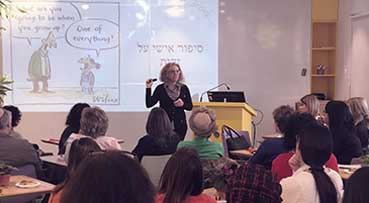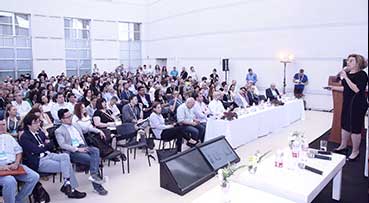I received my first laptop over two decades ago, when my eldest was born. My workplace wanted to help me balance work-life, so I won’t need to stay late at the office, so that I could also work from home. Mobility was a great new tool to help manage the various needs of work and life. But we quickly got to see the other side of mobility, that having a laptop removed the physical boundaries between work and home, that instead of reading a book or watching TV, we checked our email also at 10pm. And all this began before we had internet at home, or wireless or a smartphone…
At the end of another weekend I picked up my smartphone and discovered dozens of messages on a number of chat groups. Some of which addressed me personally. I let my smartphone take a break over the weekend, I shared with the chat group. No, not due to religious reasons, for sanity. And this is how this post was born, when one of my regular readers asked me to write about workaholics, those who cannot disconnect from work and make time for family, friends, relaxation or even doing nothing.
I first heard the statement : From constantly connected to occasionally disconnected at a talk by Intel’s anthropologist Genevieve Bell. Bell claims that, though we live in a time of constant change, those most important things to us as human beings change a lot slower, if at all. And one of those is our need for downtime, the time for our brain to relax, be bored, free up for observation, the kind that allows new ideas to surface. The blurring boundaries between what used to be time for work, time for family, for doing whatever we chose to do when we didn’t work, these blurring lines prevent us from living in a different state during the day, the week, the year. If you can remember yourself as a child before technology, you might recall spending time out in the streets or the fields, allowing your imagination to run free. We still need that time out, but now we need to make sure we build in time to have it. In different cultures, there are different ways to define the passing time. Weekends and holidays, hours or times for prayer and celebration, these are all examples of time created to shift our attention to something else, allowing for relaxation, for family, prayer, community, even silence and reflection. Technology does not cooperate with this human need since it is constantly connected. But human beings need to occasionally disconnect.
This 24*7 connected mode also enables us to work from anywhere and anytime, thus raising the questions about the mix of work and not-work, typically referred to as “life”. A WorldatWork research paper from 2009 discussed what was then an emerging dilemma. On the other hand, employees value the ability to connect from anywhere, since it allows them to manage their time more flexibly, thus contributing to their ability to manage their work-life needs. On the other hand, they also reported working more due to the ability to work from anywhere and at any time. So when I was asked to talk to a large organization about work-life balance, I used the opportunity to check what had changed, and why is it, we seem to be less concerned with this subject though we are more connected than ever before. In today’s world, can we even disconnect from work?
Any conversation on work-life needs to begin with the topic name itself. We used to call it “work-life balance”. What balance? There was no, and will never be a balance. At best, we could manage the different needs for balance over our lifetime, more likely manage the challenges. I personally like the evolution of the topic’s name to work-life fit, or as one blogger put it:
The balance doesn’t work, we already know this. I don’t want to choose. I want a blended life
Remember when work-life used to be a gender conversation? Much of the relevant world of work evolved based on the basis of a workforce of working men with wives who either stayed home or had what was defined as a “second income” job, one that allowed time for the traditional roles of family. Over the years a number of variables in this story changed significantly. The “traditional” family expanded to include additional types of families and in many of these, if they had two adults in them, both were working. Many spouses now have a full time careers, no longer defined as a secondary job or income. This raises the need to coordinate house and family responsibilities between both spouses. And on top of these, many of today’s men no longer want a career which puts the family or any other personal needs a far second place.
A US study on the changing workforce found that men now report even more work-life challenges than women. Between 1977 and 2008, about 40% of mothers of children under the age of 18 reported work-life conflict, a relatively steady percentage. Over these three decades, men in these dual earning households reported such conflict, growing from 35% to 60%.
So, no longer only a gender conversation, how do we balance the benefits of connectivity and work-from-anywhere-and-anytime with its downsides?
A University of Chicago study found that our connectivity with social media is more addictive than cigarettes or alcohol. According to the study, we do not even attempt to avoid constant connectivity because we don’t understand the consequences. In other words, we don’t understand what it is costing us.
Over the last few years we have seen some organizations and even policy makers try to tackle the implications of constant connectivity. Volkswagen, for example, tried a few years ago in Germany to stop email traffic to handheld devices after work hours. Ferrari implemented a policy in 2013 which prevented more than 3 recipients on email, in an attempt to reduce email overload. We recently saw a number of headlines in European countries, proposing legislation to limit email after hours. As of this day, it seems technology will not slow down and the blurring lines between work and off-work hours will not go back to where they once were. Which is why managing our time is up to us alone.
If we understand that constant connectivity is a type of addiction, then the way to help ourselves disconnect involves setting boundaries. Time is not unlimited, and only if we limit the time we devote to any given part of our lives, will we leave time for other parts we deem important. According to Nathan Zeldes, a senior technologist specializing in guiding worldwide adoption of new IT tools and innovative work paradigms, we waste 20% of our time taking care of unimportant email and other workplace interrupts. Think about it, that’s a whole day per week! You might want to check out the collection of tips and resources at both the individual and organizational level. These include dedicating specific hours for email and not using your inbox as a To Do List. I learned from Nathan many years ago not to reply-all and think, truly consider, who needs to be on your distribution list. I’ve seen a large organization discover that having everyone and then some on the distribution lists was a result of everyone thinking they were expected to have all the answers on anything when asked. It then became a wonderful cultural conversation. Can you say “I don’t know, let me get back to you?” You won’t believe the benefits this process had to work-life, to culture, to productivity…
The Swedes have a word for this concept of managing for balance. They call it Lagom, loosely translated in moderation. It is about a culture aiming for balance between the needs of the group and that of the individual and includes defining a work week of 40 or 50 hours and trusting employees to manage their tasks within it. How do you do it? Prioritize within a given timeframe.
At the end of the day, we manage our time. At work, clear priorities will help us ensure that we work on what is important and let go of what we cannot get to. Learning to say “no” to what is no longer important or an be delegated is important. That is true also at home, where we might call it receiving or even buying help. And yes, we manage our time also out of work. Do you know what you spend it on? Every time we check email on our devices that is a choice we are making. Does every email require an immediate response? Do you have to work evenings or weekends or do you choose to do so? That might be OK, as long as you know you are choosing and that you can be choosing to do something else.
In this digital world, much of our ability to disconnect has to do with boundaries. And only we can put those for ourselves. So when you are on “life” or “home” hours, do it with intention. If you value your free time, others will learn to respect it.
The generations joining the workplace have a completely different view of work-life. They do not accept the separation between “work” and “life”. In an enlightening post Twentysomething: Why I don’t want work/life balance a Y generation writer represents the definition of success as a work AND life, and, not or:
My purpose is to be successful, genuinely happy and to make a difference in this world somewhere along the way. Not a single one of these values can take a backseat to another. The lines between work and life have been blurred for years. I have decided to embrace this fact and work on the best blend for my life
And so beyond the question how we balance our time between work and off-work, we should first and foremost make sure we love what we do.

![large-AX1A2125-2[1]](https://niritcohen.com/wp-content/uploads/elementor/thumbs/large-AX1A2125-21-pnzedcs72atx5aeurqytqdiihxixlq02re9mlz805s.jpg)






